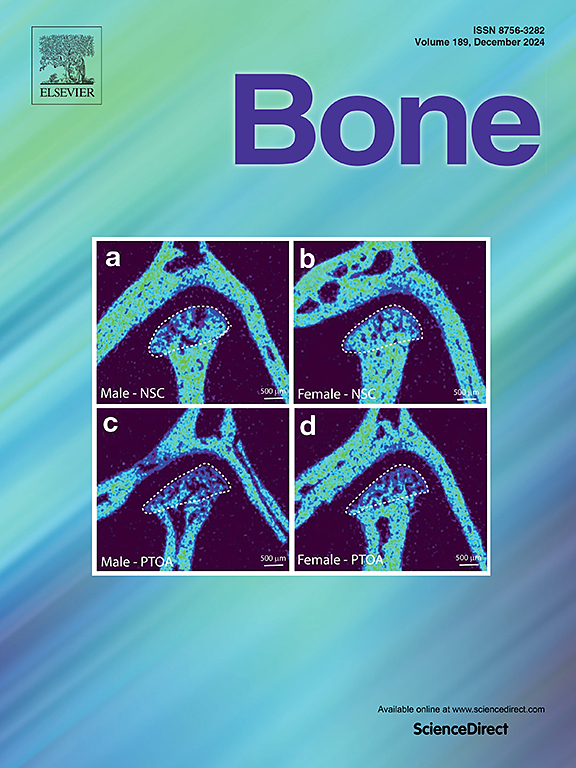Dynamic control of mTORC1 facilitates bone healing in mice
IF 3.5
2区 医学
Q2 ENDOCRINOLOGY & METABOLISM
引用次数: 0
Abstract
Bone healing requires well-orchestrated sequential actions of osteoblasts and osteoclasts. Previous studies have demonstrated that the mechanistic target of rapamycin complex 1 (mTORC1) plays a critical role in the metabolism of osteoblasts and osteoclasts. However, the role of mTORC1 in bone healing remains unclear. Here, we showed that a dynamic change in mTORC1 activity during the process was essential for proper healing and can be harnessed therapeutically for treatment of bone fractures. Low mTORC1 activity induced by osteoblastic Raptor knockout or rapamycin treatment promoted osteoblast-mediated osteogenesis, thus leading to better bone formation and shorter bone union time. Rapamycin treatment in vitro also revealed that low mTORC1 activity enhanced osteoblast differentiation and maturation. However, rapamycin treatment affected the recruitment of osteoclasts to new bone sites, thus resulting in delayed callus absorption in bone marrow cavity. Mechanistically, decreased mTORC1 activity inhibited the recruitment of osteoclast progenitor cells to healing sites through a decrease in osteoblastic expression of monocyte chemoattractant protein-1, thus inhibiting osteoclast-mediated remodeling. Therefore, normal mTORC1 activity was necessary for bone remodeling stage. Furthermore, through the use of sustained-release materials at the bone defect, we confirmed that localized application of rapamycin in early stages accelerated bone healing without affecting bone remodeling. Together, these findings revealed that the activity of mTORC1 continually changed during bone healing, and staged rapamycin treatment could be used to promote bone healing.
动态控制 mTORC1 可促进小鼠骨愈合。
骨骼愈合需要成骨细胞和破骨细胞协调有序的作用。以往的研究表明,雷帕霉素复合体 1(mTORC1)的机制靶标在成骨细胞和破骨细胞的新陈代谢中发挥着关键作用。然而,mTORC1 在骨愈合中的作用仍不清楚。在这里,我们发现,在骨愈合过程中,mTORC1活性的动态变化对正常愈合至关重要,并可用于治疗骨折。成骨细胞Raptor基因敲除或雷帕霉素治疗诱导的低mTORC1活性促进了成骨细胞介导的成骨,从而导致更好的骨形成和更短的骨结合时间。雷帕霉素体外处理也表明,低 mTORC1 活性可促进成骨细胞分化和成熟。然而,雷帕霉素处理会影响破骨细胞向新骨部位的募集,从而导致骨髓腔中的胼胝体吸收延迟。从机制上讲,mTORC1活性的降低通过降低成骨细胞表达单核细胞趋化蛋白-1,抑制了破骨细胞祖细胞向愈合部位的募集,从而抑制了破骨细胞介导的重塑。因此,正常的 mTORC1 活性是骨重塑阶段的必要条件。此外,通过在骨缺损处使用缓释材料,我们证实在早期局部应用雷帕霉素可加速骨愈合而不影响骨重塑。这些发现共同揭示了mTORC1的活性在骨愈合过程中不断发生变化,因此可以利用雷帕霉素的分阶段治疗来促进骨愈合。
本文章由计算机程序翻译,如有差异,请以英文原文为准。
求助全文
约1分钟内获得全文
求助全文
来源期刊

Bone
医学-内分泌学与代谢
CiteScore
8.90
自引率
4.90%
发文量
264
审稿时长
30 days
期刊介绍:
BONE is an interdisciplinary forum for the rapid publication of original articles and reviews on basic, translational, and clinical aspects of bone and mineral metabolism. The Journal also encourages submissions related to interactions of bone with other organ systems, including cartilage, endocrine, muscle, fat, neural, vascular, gastrointestinal, hematopoietic, and immune systems. Particular attention is placed on the application of experimental studies to clinical practice.
 求助内容:
求助内容: 应助结果提醒方式:
应助结果提醒方式:


